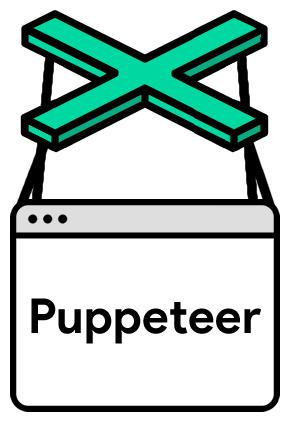API | FAQ | Contributing
Puppeteer is a Node library which provides a high-level API to control headless Chrome over the DevTools Protocol. It can also be configured to use full (non-headless) Chrome.
Most things that you can do manually in the browser can be done using Puppeteer! Here are a few examples to get you started:
- Generate screenshots and PDFs of pages.
- Crawl a SPA and generate pre-rendered content (i.e. "SSR").
- Scrape content from websites.
- Automate form submission, UI testing, keyboard input, etc.
- Create an up-to-date, automated testing environment. Run your tests directly in the latest version of Chrome using the latest JavaScript and browser features.
- Capture a timeline trace of your site to help diagnose performance issues.
Give it a spin: https://try-puppeteer.appspot.com/
Note: Puppeteer requires at least Node v6.4.0, but the examples below use async/await which is only supported in Node v7.6.0 or greater
To use Puppeteer in your project, run:
yarn add puppeteer
# or "npm i puppeteer"
Note: When you install Puppeteer, it downloads a recent version of Chromium (~71Mb Mac, ~90Mb Linux, ~110Mb Win) that is guaranteed to work with the API. To skip the download, see Environment variables.
Puppeteer will be familiar to people using other browser testing frameworks. You create an instance
of Browser, open pages, and then manipulate them with Puppeteer's API.
Example - navigating to https://example.com and saving a screenshot as example.png:
const puppeteer = require('puppeteer');
(async () => {
const browser = await puppeteer.launch();
const page = await browser.newPage();
await page.goto('https://example.com');
await page.screenshot({path: 'example.png'});
await browser.close();
})();Puppeteer sets an initial page size to 800px x 600px, which defines the screenshot size. The page size can be customized with Page.setViewport().
Example - create a PDF.
const puppeteer = require('puppeteer');
(async () => {
const browser = await puppeteer.launch();
const page = await browser.newPage();
await page.goto('https://news.ycombinator.com', {waitUntil: 'networkidle2'});
await page.pdf({path: 'hn.pdf', format: 'A4'});
await browser.close();
})();See Page.pdf() for more information about creating pdfs.
Example - evaluate script in the context of the page
const puppeteer = require('puppeteer');
(async () => {
const browser = await puppeteer.launch();
const page = await browser.newPage();
await page.goto('https://example.com');
// Get the "viewport" of the page, as reported by the page.
const dimensions = await page.evaluate(() => {
return {
width: document.documentElement.clientWidth,
height: document.documentElement.clientHeight,
deviceScaleFactor: window.devicePixelRatio
};
});
console.log('Dimensions:', dimensions);
await browser.close();
})();See Page.evaluate() for more information on evaluate and related methods like evaluateOnNewDocument and exposeFunction.
1. Uses Headless mode
Puppeteer launches Chromium in headless mode. To launch a full version of Chromium, set the 'headless' option when launching a browser:
const browser = await puppeteer.launch({headless: false}); // default is true2. Runs a bundled version of Chromium
By default, Puppeteer downloads and uses a specific version of Chromium so its API
is guaranteed to work out of the box. To use Puppeteer with a different version of Chrome,
pass in the executable's path when creating a Browser instance:
const browser = await puppeteer.launch({executablePath: '/path/to/Chrome'});See Puppeteer.launch() for more information.
3. Creates a fresh user profile
Puppeteer creates its own Chromium user profile which it cleans up on every run.
Explore the API documentation and examples to learn more.
-
Turn off headless mode - sometimes it's useful to see what the browser is displaying. Instead of launching in headless mode, launch a full version of Chrome using
headless: false:const browser = await puppeteer.launch({headless: false});
-
Slow it down - the
slowMooption slows down Puppeteer operations by the specified amount of milliseconds. It's another way to help see what's going on.const browser = await puppeteer.launch({ headless: false, slowMo: 250 // slow down by 250ms });
-
Capture console output - You can listen for the
consoleevent. This is also handy when debugging code inpage.evaluate():page.on('console', msg => console.log('PAGE LOG:', ...msg.args)); await page.evaluate(() => console.log(`url is ${location.href}`));
-
Enable verbose logging - All public API calls and internal protocol traffic will be logged via the
debugmodule under thepuppeteernamespace.# Basic verbose logging env DEBUG="puppeteer:*" node script.js # Debug output can be enabled/disabled by namespace env DEBUG="puppeteer:*,-puppeteer:protocol" node script.js # everything BUT protocol messages env DEBUG="puppeteer:session" node script.js # protocol session messages (protocol messages to targets) env DEBUG="puppeteer:mouse,puppeteer:keyboard" node script.js # only Mouse and Keyboard API calls # Protocol traffic can be rather noisy. This example filters out all Network domain messages env DEBUG="puppeteer:*" env DEBUG_COLORS=true node script.js 2>&1 | grep -v '"Network'
Check out contributing guide to get an overview of Puppeteer development.
Look for chromium_revision in package.json.
Puppeteer bundles Chromium to ensure that the latest features it uses are guaranteed to be available. As the DevTools protocol and browser improve over time, Puppeteer will be updated to depend on newer versions of Chromium.
Selenium / WebDriver is a well-established cross-browser API that is useful for testing cross-browser support.
Puppeteer works only with Chrome. However, many teams only run unit tests with a single browser (e.g. PhantomJS). In non-testing use cases, Puppeteer provides a powerful but simple API because it's only targeting one browser that enables you to rapidly develop automation scripts.
Puppeteer uses the latest versions of Chromium.
The Chrome DevTools team maintains the library, but we'd love your help and expertise on the project! See Contributing.
The goals of the project are simple:
- Provide a slim, canonical library that highlights the capabilities of the DevTools Protocol.
- Provide a reference implementation for similar testing libraries. Eventually, these other frameworks could adopt Puppeteer as their foundational layer.
- Grow the adoption of headless/automated browser testing.
- Help dogfood new DevTools Protocol features...and catch bugs!
- Learn more about the pain points of automated browser testing and help fill those gaps.
The past few months have brought several new libraries for automating headless Chrome. As the team authoring the underlying DevTools Protocol, we're excited to witness and support this flourishing ecosystem.
We've reached out to a number of these projects to see if there are opportunities for collaboration, and we're happy to do what we can to help.



